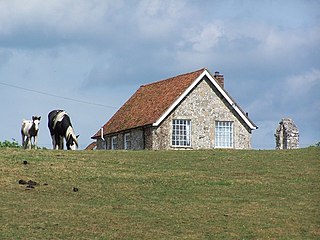Related Research Articles

Edington is a village and civil parish in Wiltshire, England, about 4 miles (6 km) east-northeast of Westbury. The village lies under the north slope of Salisbury Plain and the parish extends south onto the Plain. Its Grade I listed parish church was built for Edington Priory in the 14th century.

Wilsford is a small village and civil parish in the Vale of Pewsey in the English county of Wiltshire, about 4 miles (6 km) southwest of Pewsey.

Barford St Martin is a village and civil parish in Wiltshire, England, about 2.5 miles (4 km) west of Wilton, around the junction of the A30 and the B3089. Barford is known as one of the Nadder Valley villages, named for the River Nadder which flows through the parish.

Limpley Stoke is a village and civil parish in Wiltshire, England. It lies in the Avon valley between Bath and Freshford, and is both above and below the A36 road.

Monkton Farleigh is a village and civil parish in west Wiltshire, England, on high ground 3 miles (5 km) northwest of Bradford-on-Avon, and a similar distance east of the city of Bath. The parish includes the hamlets of Farleigh Wick and Pinckney Green. In the west and northwest the parish is bounded by Somerset.

Knook is a small village and civil parish in Wiltshire, England. The village lies to the north of the River Wylye at the edge of Salisbury Plain, about 4+1⁄2 miles (7 km) southeast of Warminster, close to the A36 road to Salisbury.

Fugglestone St Peter was a small village, manor, and civil parish in Wiltshire, England, lying between the town of Wilton and the city of Salisbury. The civil parish came to an end in 1894 when it was divided between the adjoining parishes, and today Fugglestone is a largely residential area in the north of Wilton parish; however, the 13th-century parish church survives.

The Franciscan Friary of Southampton was founded c. 1233. It occupied a south-eastern area of the city, within the walls and adjacent to God's House Tower. The friary was notable for its water supply system, which supplied water for use by the friars themselves and by the other inhabitants of Southampton. The friary was dissolved in 1538 and the last remains were swept away in the 1940s. The site is now occupied by Friary House. Elsewhere, remnants of the extensive water supply system still survive today.
Newcastle-under-Lyme Friary was a religious house of Dominican friars in Newcastle-under-Lyme, Staffordshire, England. Founded sometime in the 13th century, it was a surrendered to the Crown in 1538, during the Dissolution of the Monasteries.
St Richard's Friary, also known as Pontefract Friary, was a Dominican friary in Pontefract, West Yorkshire, England. It was located near today's Pontefract General Infirmary, on the eastern edge of Friarwood Valley Gardens.
Ansty Preceptory was a medieval monastic house in Wiltshire, England, founded by the Order of Knights of the Hospital of Saint John of Jerusalem.

Ivychurch Priory was a medieval monastic house in Alderbury, southeast of Salisbury, Wiltshire, England. According to Historic England, "all that remains is a cylindrical pier with multi-scalloped capital and part of the double-chamfered arch with a respond to the west with a half-pier and capital; this is attached to the west wall of the church which retains one buttress".
The Priory of St Mary Magdalene was a Cluniac priory in Monkton Farleigh, Wiltshire, England, in the 12th to 16th centuries.
Salisbury Grey Friary was a friary in Wiltshire, England between the 1230s and 1538.
Tisbury Grange was a priory in Wiltshire, England.

Upavon Priory was a small priory in Wiltshire, England.
The Devizes County House of Corrections or Devizes Prison was a correctional facility in Devizes, Wiltshire, England. It opened in 1817, replacing the Old Bridewell prison, and fell out of use after around a hundred years. For a time it was the only prison in Wiltshire.

North Newnton is a civil parish in Wiltshire, England, 2.5 miles (4.0 km) southwest of Pewsey. The parish is in the Vale of Pewsey which carries the upper section of the Salisbury Avon.

Lacock Abbey was a monastery founded at Lacock, in the county of Wiltshire in England, in the early 13th century by Ela, Countess of Salisbury, as a house of Augustinian Canonesses regular. It was seized by the crown in 1539 during the Dissolution of the Monasteries under Henry VIII. It then became a country house, Lacock Abbey, notable as the site of Henry Fox Talbot's early experiments in photography.
The Salisbury Bell Foundry at Salisbury, in Wiltshire, England, was operated from at least 1420 until 1731. The surnames of notable master bell-founders include Purdue and Wallis.
References
- 1 2 Pugh, R.B.; Crittall, Elizabeth, eds. (1956). "Houses of Dominican friars: Salisbury". A History of the County of Wiltshire, Volume 3. Victoria County History. University of London. pp. 331–333. Retrieved 21 October 2023– via British History Online.
- ↑ Pugh, R.B.; Crittall, Elizabeth, eds. (1956). "Houses of Dominican friars: Wilton". A History of the County of Wiltshire, Volume 3. Victoria County History. University of London. pp. 330–331. Retrieved 21 October 2023– via British History Online.
- 1 2 Historic England. "Salisbury Blackfriars (218470)". Research records (formerly PastScape). Retrieved 21 October 2023.
- 1 2 "Salisbury Sites 32: The Maltings". Wessex Archaeology. 11 September 2020. Retrieved 21 October 2023.
- ↑ Palmer, C. F. R. (1879). "The Black Friars of Wiltshire: Salisbury". Wiltshire Archaeological and Natural History Magazine . 18 (53): 165–176 – via Biodiversity Heritage Library
 .
.
51°04′10″N1°47′57″W / 51.0695°N 1.7993°W